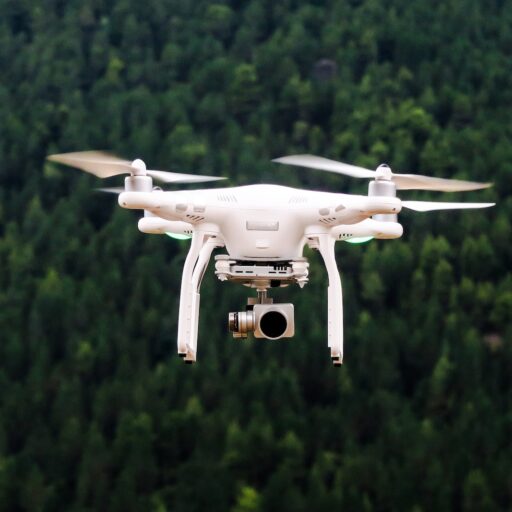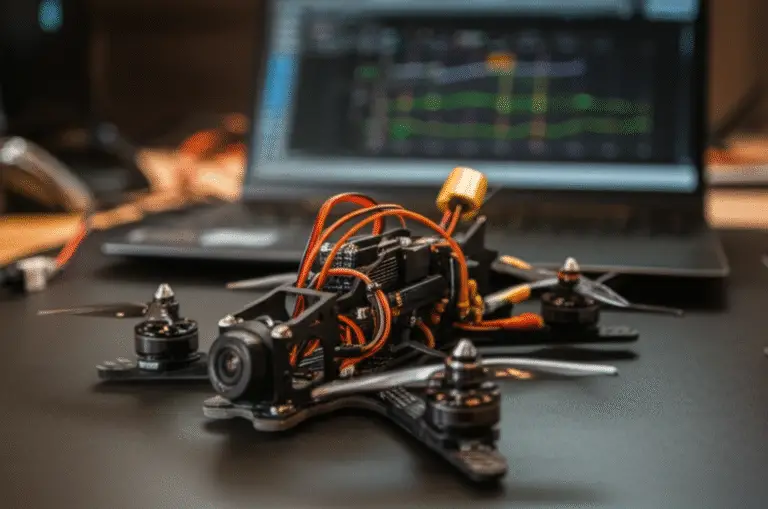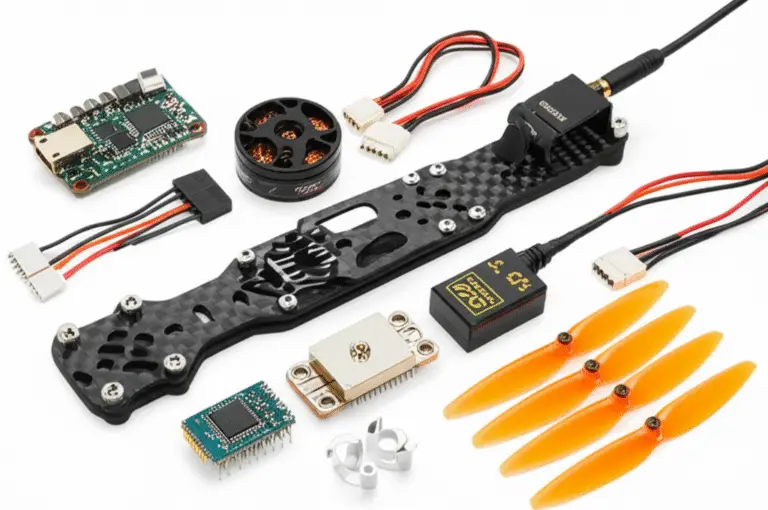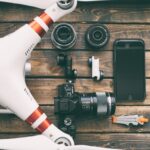Support our educational content for free when you purchase through links on our site. Learn more
The Ultimate Guide to FPV Drones in 2025: 10 Must-Know Facts 🚁
Strap in and prepare for takeoff—FPV drones are transforming the way we experience flight, blending adrenaline-pumping racing, cinematic magic, and even battlefield tactics into one electrifying package. Whether you’re a curious beginner itching to pilot your first drone or a seasoned flyer looking to upgrade your gear, this guide from the drone pilots at Drone Brands™ has you covered. From the nuts and bolts of drone anatomy to the top 10 models dominating 2025, plus insider tips on customization and legal must-knows, we’ll help you navigate the thrilling skies of FPV flying.
Did you know that FPV drones have been used in real combat scenarios with surprising effectiveness, yet still face serious limitations? Or that mastering FPV flight can take months but rewards you with an unmatched immersive experience? Keep reading to discover the secrets behind the goggles, the best drones for every skill level, and why sometimes FPV drones aren’t the perfect solution—plus how to avoid common pitfalls.
Key Takeaways
- FPV drones provide a first-person, immersive flying experience using live video feeds transmitted to goggles or screens.
- The technology has evolved rapidly, with digital HD systems like DJI FPV revolutionizing video quality and latency.
- Choosing the right drone depends on your skill level and purpose, from beginner-friendly models like BetaFPV Cetus Pro to pro racers like iFlight Nazgul5.
- Customization is a big part of FPV culture, allowing upgrades to motors, cameras, and transmitters for enhanced performance.
- FPV drones have real-world applications beyond hobby flying, including search and rescue, agriculture, and even military use.
- Legal regulations vary widely, so always check local laws and fly responsibly with a spotter.
- Expect a learning curve and some crashes, but with practice and the right gear, FPV flying is incredibly rewarding.
Ready to find your perfect FPV drone?
- Shop top models: DJI FPV Combo | BetaFPV Cetus Pro | iFlight Nazgul5
- Explore beginner gear: Beginner Drones at Drone Brands™
- Stay updated: Drone Industry News
Table of Contents
- ⚡️ Quick Tips and Facts About FPV Drones
- 🚀 The Evolution of FPV Drones: From Hobbyist Toys to High-Tech Flyers
- 🛠️ Anatomy of an FPV Drone: What Makes It Fly?
- 🎯 7 Essential FPV Drone Components You Need to Know
- 📡 How FPV Drone Technology Works: The Magic Behind the Goggles
- 🏆 Top 10 FPV Drones for Beginners and Pros in 2024
- ⚙️ Customizing Your FPV Drone: Tips, Tricks, and Must-Have Upgrades
- 🛡️ FPV Drones and National Security: What You Should Know
- 🔥 Real Talk: Why FPV Drones Aren’t Always the Perfect Solution
- 🌍 FPV Drones in Action: Amazing Use Cases and Stories from the Field
- 🎮 FPV Drone Racing: The Ultimate Adrenaline Rush
- 📜 Legal Landscape: Navigating FPV Drone Laws and Regulations
- 💡 Pro Tips for Flying FPV Drones Like a Champ
- 🔧 Troubleshooting Common FPV Drone Issues
- 📚 Recommended Links for FPV Drone Enthusiasts
- ❓ FAQ: Your Burning FPV Drone Questions Answered
- 📖 Reference Links and Further Reading
- 🏁 Conclusion: Taking Your FPV Drone Experience to New Heights
⚡️ Quick Tips and Facts About FPV Drones
Welcome to the thrilling world of FPV drones—where you’re not just flying a drone, you are the drone! At Drone Brands™, our aerial adventurers have logged hundreds of hours piloting these nimble flyers, and we’re here to share the juiciest nuggets of wisdom to get you soaring with confidence. 🚁
Quick FPV Drone Facts:
- FPV = First-Person View: You wear goggles or use a screen to see live video from the drone’s onboard camera, giving you a pilot’s-eye perspective.
- Popular Frequencies: 5.8 GHz is the go-to for most FPV pilots due to low interference and no license needed, but 900 MHz offers better range and penetration (license required).
- Flight Style: FPV drones are built for agility and speed, often used in racing and freestyle flying.
- Battery Life: Typically short—around 3 to 7 minutes for racing drones, longer for cinematic setups.
- Skill Level: FPV flying has a steep learning curve; expect to crash a lot at first! Practice is key.
- Legal Note: Always check local drone laws before flying. FPV flying often requires a spotter to maintain visual line of sight (see Drone Laws and Regulations).
Pro Tip: Start with a simulator like Liftoff or VelociDrone before taking to the skies. It saves your wallet and sanity!
Curious about how FPV drones evolved from hobbyist toys to high-tech marvels? Hang tight—we’re just getting warmed up! 🔥
🚀 The Evolution of FPV Drones: From Hobbyist Toys to High-Tech Flyers FPV drones have come a long way since the early days of clunky RC planes with cameras duct-taped on. Back in the late 2000s, the FPV scene was niche, with DIY enthusiasts cobbling together analog video transmitters and bulky goggles. Fast forward to 2024, and FPV drones are a multi-billion-dollar industry powering everything from adrenaline-pumping races to Hollywood cinematography (hello, Red Notice!). 🎬
Key Milestones in FPV Drone Evolution:
- Early 2000s: Analog video feeds with limited range and poor image quality.
- 2010s: Introduction of lightweight 5.8 GHz transmitters and affordable FPV goggles like Fat Shark.
- Mid-2010s: Rise of racing leagues such as the Drone Racing League (DRL), pushing drone tech and pilot skills.
- Late 2010s: Digital FPV systems emerge (e.g., DJI FPV), offering HD video and lower latency.
- 2020s: Integration of AI-assisted flight modes, obstacle avoidance, and improved battery tech.
Our team remembers the thrill of flying the first DJI FPV combo—crystal-clear video with near-zero lag—a game-changer for aerial adventures.
Want to see FPV drones in action and learn how to start flying in 2025? Check out the featured video for an immersive introduction.
🛠️ Anatomy of an FPV Drone: What Makes It Fly?
Before you take control, it’s crucial to understand what’s under the hood. FPV drones are marvels of compact engineering, balancing power, agility, and video transmission.
Core Components:
| Component | Function | Notes | |
|---|---|---|---|
| Frame | Structural skeleton | Carbon fiber frames are lightweight and durable | |
| Motors | Provide thrust and control direction | Brushless motors preferred for efficiency | |
| Electronic Speed Controllers (ESCs) | Regulate motor speed | Sync with flight controller Flight Controller The drone’s brain | Stabilizes flight, processes pilot input |
| FPV Camera | Captures live video feed | Usually low latency, wide-angle | |
| Video Transmitter (VTx) | Sends video signal to goggles or monitor | Power output affects range | |
| Antennas | Enhance signal transmission and reception | Directional antennas improve range | |
| Battery | Powers the drone | LiPo batteries common, high discharge rate | |
| Radio Receiver | Receives pilot commands | Paired with transmitter |
Our pilots swear by TBS (Team BlackSheep) and ImmersionRC for reliable VTx gear, while Holybro and BetaFPV offer solid flight controllers for beginners and pros alike.
🎯 7 Essential FPV Drone Components You Need to Know
Let’s break down the seven must-know components that define your FPV experience:
- FPV Goggles: Your window to the drone’s world. Fat Shark Dominator and DJI FPV Goggles V2 are fan favorites.
- Transmitter (Controller): The joystick in your hands. FrSky Taranis and Radiomaster TX16S offer great range and customization.
- Flight Controller: Handles stabilization and flight modes. Betaflight and KISS are popular firmware choices.
- Motors: Brushless motors with appropriate KV rating (RPM per volt) for your drone size.
- ESCs: Should support your motor’s current draw and offer features like BLHeli firmware for smooth throttle response.
- FPV Camera: Low latency is key; Caddx and RunCam produce some of the best.
- Video Transmitter (VTx): Power output (25mW to 800mW) affects range but beware of local regulations.
Pro Tip: Balance power and weight—oversized batteries or motors can reduce flight time and agility.
📡 How FPV Drone Technology Works: The Magic Behind the Goggles
Ever wondered how your drone’s camera feed streams live to your goggles without a hitch? Here’s the tech lowdown:
- Camera captures real-time video and sends it to the VTx.
- VTx broadcasts the analog or digital signal over a specific frequency (usually 5.8 GHz).
- Goggles or monitor receive the signal via a video receiver module and display it with minimal latency.
- Control commands flow from your transmitter to the drone’s receiver, then to the flight controller, which adjusts motors accordingly.
Analog vs. Digital FPV:
| Feature | Analog FPV | Digital FPV (e.g., DJI FPV) |
|---|---|---|
| Latency | Ultra-low (~20-30 ms) | Slightly higher (~30-50 ms) |
| Video Quality | Standard Definition | HD 720p or 1080p |
| Range | Up to 2-3 km with good antennas | Typically shorter (~1-2 km) |
| Interference | Prone to signal noise | More robust with encryption |
| Cost | Generally cheaper | More expensive |
Our pilots often prefer analog for racing due to low latency but switch to digital for cinematic flights.
🏆 Top 10 FPV Drones for Beginners and Pros in 2024
Ready to pick your flying companion? Here’s our expert-rated table of the hottest FPV drones, balancing design, functionality, durability, and ease of use.
| Drone Model | Design (1-10) | Flight Performance (1-10) | Camera Quality (1-10) | Durability (1-10) | Beginner Friendly (✅/❌) | Recommended Use |
|---|---|---|---|---|---|---|
| DJI FPV Combo | 9 | 9 | 10 | 8 | ✅ | Cinematic & Racing |
| BetaFPV Cetus Pro | 7 | 7 | 6 | 7 | ✅ | Indoor & Beginners |
| EMAX Tinyhawk III | 8 | 8 | 7 | 7 | ✅ | Indoor & Outdoor |
| iFlight Nazgul5 | 8 | 9 | 8 | 9 | ❌ | Racing & Freestyle |
| Holybro Kopis 2 | 9 | 9 | 9 | 9 | ❌ | Racing & Freestyle |
| GEPRC CineQueen | 8 | 8 | 9 | 8 | ❌ | Cinematic FPV |
| Walkera F210 3D | 7 | 8 | 7 | 7 | ❌ | Racing |
| Eachine Wizard X220S | 7 | 8 | 7 | 7 | ❌ | Racing |
| BetaFPV Pavo30 | 7 | 7 | 6 | 7 | ✅ | Micro FPV & Beginners |
| Diatone Roma F5 | 8 | 9 | 8 | 9 | ❌ | Racing & Freestyle |
Our Take: For newbies, the DJI FPV Combo and BetaFPV Cetus Pro are fantastic entry points. For seasoned pilots craving speed and agility, the iFlight Nazgul5 and Holybro Kopis 2 deliver pro-level thrills.
👉 CHECK PRICE on:
- DJI FPV Combo: Amazon | DJI Official Website
- BetaFPV Cetus Pro: Amazon | BetaFPV Official
- iFlight Nazgul5: Amazon | iFlight Official
⚙️ Customizing Your FPV Drone: Tips, Tricks, and Must-Have Upgrades
One of the joys of FPV flying is making your drone truly yours. Whether you want more speed, longer flight times, or better video, customization is king.
Popular Upgrades:
- Motors: Upgrade to higher KV brushless motors for more punch.
- ESCs: Opt for 4-in-1 ESCs with BLHeli_32 firmware for smoother throttle response.
- Batteries: Use higher capacity LiPo batteries (e.g., 4S or 6S) for longer flights and more power.
- FPV Camera: Swap for a Caddx Ratel or RunCam Phoenix for improved low-light performance.
- VTx: Upgrade to a 600-800mW transmitter for extended range (check local regulations!).
- Propellers: Experiment with different sizes and pitches to balance speed and control.
- Frame: Carbon fiber frames reduce weight and improve durability.
Our Story: One of our pilots swapped out stock motors on a BetaFPV Cetus Pro for 1106 4500KV motors and instantly felt the difference—more responsive, more fun!
Warning: Upgrading components can void warranties and may require soldering skills. Always test in a safe environment.
🛡️ FPV Drones and National Security: What You Should Know
FPV drones aren’t just toys—they’ve become tools with serious implications for national security. The War on the Rocks article reveals how FPV drones have been used as suicide drones in the Russo-Ukrainian conflict, carrying explosives to strike targets with precision.
Key Insights:
- FPV drones provide cheap, organic precision-strike capability for tactical troops.
- Success rates hover around 43% for successful strikes, but many missions fail due to technical and environmental challenges.
- Electronic warfare (EW) and jamming severely limit effectiveness.
- FPV drones are vulnerable to signal interference and lack night vision capabilities.
- Commanders often use them for “double-tap” strikes rather than primary attacks.
- Fiber-optic tethered drones offer some improvements but have maneuverability and cost drawbacks.
What This Means for You: While FPV drones are incredible for hobbyists and professionals alike, their military use highlights both their potential and limitations. If you’re curious about the intersection of drones and security, check out our Drone Industry News for the latest updates.
🔥 Real Talk: Why FPV Drones Aren’t Always the Perfect Solution
We love FPV drones, but let’s not kid ourselves—they have their quirks and frustrations. Here’s the lowdown from our pilots’ frontline experience:
- Fragility: FPV drones crash. A lot. Carbon fiber frames help, but repairs are part of the game.
- Short Flight Times: Batteries drain fast, especially when pushing throttle. Plan for quick sorties.
- Signal Loss: Flying behind buildings or trees can cause video dropouts or loss of control.
- Training Required: FPV flying isn’t plug-and-play. It demands patience and practice.
- Weather Sensitive: Wind, rain, fog, and darkness can ground your drone.
- Cost of Consumables: Props, batteries, and occasional crashes add up.
Our pilot Jake once lost a drone mid-flight due to unexpected jamming during a race—talk about a heart-stopper! 😱
Still, the rush of flying FPV is unmatched. Just know what you’re signing up for.
🌍 FPV Drones in Action: Amazing Use Cases and Stories from the Field
FPV drones aren’t just for racing or military ops—they’re revolutionizing industries and hobbies:
- Cinematography: Filmmakers use FPV drones for dynamic shots impossible with traditional drones. The movie Red Notice showcased this beautifully.
- Search and Rescue: FPV drones navigate tight spaces to locate missing persons or assess disaster zones.
- Agriculture: Precision mapping and crop monitoring with FPV drones improve yields.
- Freestyle Flying: Pilots perform jaw-dropping aerial acrobatics, pushing drone capabilities.
- Racing: The adrenaline-fueled sport of FPV drone racing is growing globally, with leagues like DRL and MultiGP.
Our pilot Sarah recalls flying an FPV drone through a dense forest for a rescue mission—“It was like threading a needle at 60 mph!” 🌲
🎮 FPV Drone Racing: The Ultimate Adrenaline Rush
If you crave speed and competition, FPV racing is your playground. Picture this: dozens of drones zipping through complex courses at breakneck speeds, all controlled from the pilot’s perspective.
What You Need to Know:
- Courses: Often indoor or outdoor with gates, flags, and obstacles.
- Drones: Lightweight, high-thrust quads with powerful motors and low-latency video.
- Skills: Precision flying, split-second decision-making, and nerves of steel.
- Community: Racing leagues like MultiGP offer structured competition and camaraderie.
Our team’s top racer, Mike, shares: “Nothing beats the rush of crossing the finish line first, knowing you just out-flew 20 other pilots.”
📜 Legal Landscape: Navigating FPV Drone Laws and Regulations
FPV flying is exhilarating but comes with legal responsibilities. Regulations vary widely by country and even by state or region.
Key Legal Points:
- Visual Line of Sight (VLOS): Many jurisdictions require a spotter to maintain unaided visual contact with the drone during FPV flights.
- Altitude Limits: Typically capped at 400-500 feet AGL (Above Ground Level).
- No-Fly Zones: Airports, national parks, and urban centers often prohibit drone flights.
- Licensing: Some countries require pilot certification or drone registration.
- Frequency Use: Certain FPV frequencies require amateur radio licenses (e.g., 900 MHz).
- Insurance: Recommended for liability protection.
For detailed, up-to-date info, explore our Drone Laws and Regulations section.
💡 Pro Tips for Flying FPV Drones Like a Champ
Want to fly like a pro? Here are some insider tips from our seasoned pilots:
- Start Slow: Master hovering and basic maneuvers before attempting freestyle or racing.
- Use Simulators: Practice on Liftoff or VelociDrone to build muscle memory without risking your gear.
- Pre-Flight Checks: Always inspect props, battery voltage, and antenna connections.
- Fly in Open Areas: Avoid obstacles and crowds when learning.
- Keep Spare Parts: Props and batteries wear out fast—be prepared.
- Record Flights: Reviewing footage helps identify mistakes and improve.
- Join a Club: Local FPV clubs offer mentorship and safe flying environments.
🔧 Troubleshooting Common FPV Drone Issues
Even the best pilots face hiccups. Here’s how to tackle common problems:
| Issue | Possible Cause | Fix or Tip |
|---|---|---|
| No video feed to goggles | Loose VTx antenna or power issue | Check connections, replace battery |
| Drone won’t arm | Failsafe or transmitter bind issue | Rebind transmitter, check failsafe settings |
| Motors not spinning | ESC or motor wiring problem | Inspect solder joints, replace ESC or motor |
| Video interference or static | Channel conflict or weak signal | Change VTx channel, upgrade antennas |
| Short flight time | Battery degradation or heavy load | Replace battery, reduce payload |
| Drone drifts or unstable | Flight controller calibration | Recalibrate accelerometer and gyro |
Our pilot Emma once spent an entire afternoon chasing a video interference issue—turns out a neighbor’s Wi-Fi router was the culprit!
📚 Recommended Links for FPV Drone Enthusiasts
Ready to dive deeper? Here are some top resources:
- Drone Brands™ Beginner Drones
- MultiGP Drone Racing League
- Fat Shark FPV Goggles Official
- DJI FPV Drone Official
- FPV Racing Simulator Liftoff
- AMA FPV Flying Guidelines
❓ FAQ: Your Burning FPV Drone Questions Answered
Q: How long does it take to learn FPV flying?
A: Most pilots reach basic proficiency in 2-3 months with regular practice, but mastering freestyle or racing can take years.
Q: Can I fly FPV drones at night?
A: Technically yes, but it’s challenging and often illegal without proper lighting and permissions.
Q: What’s the difference between analog and digital FPV?
A: Analog offers lower latency but lower video quality; digital provides HD video but with slightly higher latency.
Q: Are FPV drones legal everywhere?
A: No. Regulations vary—always check local laws and fly responsibly.
Q: What’s the best drone for beginners?
A: The BetaFPV Cetus Pro and DJI FPV Combo are excellent starting points.
📖 Reference Links and Further Reading
- First-person view (radio control) – Wikipedia
- I Fought in Ukraine and Here’s Why FPV Drones Kind of Suck – War on the Rocks
- Pyrodrone Official Website
- FAA Drone Regulations
- Academy of Model Aeronautics FPV Guidelines
🏁 Conclusion: Taking Your FPV Drone Experience to New Heights
After soaring through the exhilarating world of FPV drones with us at Drone Brands™, you’re now equipped with the know-how to pick, fly, and even customize your own first-person view flyer. From the jaw-dropping cinematic shots of the DJI FPV Combo to the nimble indoor fun of the BetaFPV Cetus Pro, these drones offer something for every pilot’s skill level and appetite for adventure.
Positives:
✅ Immersive flying experience like no other
✅ Wide range of options from beginner-friendly to pro-level racers
✅ Thriving community and endless customization possibilities
✅ Real-world applications beyond fun—search & rescue, agriculture, and even national security
Negatives:
❌ Steep learning curve with inevitable crashes
❌ Short battery life demanding frequent swaps
❌ Susceptibility to signal interference and weather conditions
❌ Regulatory hurdles requiring careful compliance
Our confident recommendation? Start with a beginner-friendly model like the BetaFPV Cetus Pro to build your skills, then graduate to more advanced drones like the DJI FPV Combo or iFlight Nazgul5 as your confidence and ambitions grow. Remember, FPV flying is a journey—one filled with thrilling highs, occasional setbacks, and endless discovery.
Still wondering how to master those tricky maneuvers or what upgrades will truly make a difference? Keep exploring, practicing, and connecting with fellow pilots. The sky’s the limit!
📚 Recommended Links for FPV Drone Enthusiasts
Ready to gear up or dive deeper? Here are some top shopping and reading picks to fuel your FPV passion:
-
DJI FPV Combo:
Amazon | DJI Official Website | Walmart -
BetaFPV Cetus Pro:
Amazon | BetaFPV Official | eBay -
iFlight Nazgul5:
Amazon | iFlight Official -
Fat Shark Dominator FPV Goggles:
Amazon | Fat Shark Official -
FrSky Taranis Transmitter:
Amazon | FrSky Official -
Recommended Books:
❓ FAQ: Your Burning FPV Drone Questions Answered
What is the best FPV drone for beginners?
For beginners, BetaFPV Cetus Pro and DJI FPV Combo stand out. The Cetus Pro offers a gentle learning curve with durable design and beginner-friendly flight modes, while the DJI FPV Combo provides a more immersive experience with HD video and advanced safety features. Starting with these models helps you build confidence without overwhelming complexity.
How do I choose the right FPV drone for my needs?
Consider your skill level, intended use (racing, freestyle, cinematic), budget, and local regulations. Beginners should prioritize stability and ease of use, while experienced pilots may seek speed, customization, and advanced features. Also, factor in battery life and spare parts availability.
What are the key components of a good FPV drone system?
A solid FPV drone system includes:
- Reliable FPV goggles with low latency
- Responsive transmitter/controller with good range
- Durable drone frame and efficient motors
- High-quality FPV camera and video transmitter
- Flight controller with stable firmware (e.g., Betaflight)
- Batteries that balance weight and flight time
Can I build my own FPV drone or should I buy a pre-made one?
Both options are valid. Building your own drone offers customization and learning but requires soldering skills and troubleshooting patience. Pre-made drones provide convenience and warranty support, ideal for beginners or those eager to fly immediately. Many pilots start with a ready-to-fly (RTF) model and transition to building later.
What is the difference between an FPV drone and a traditional drone?
Traditional drones are usually designed for aerial photography with GPS stabilization and autonomous flight modes, often controlled by a smartphone or remote with a third-person view. FPV drones prioritize real-time video streaming to goggles, offering a pilot’s-eye view and manual control for racing or freestyle flying. FPV drones are generally more agile but require more skill.
How do I set up and calibrate my FPV drone for optimal performance?
- Calibrate accelerometer and gyroscope via your flight controller software (e.g., Betaflight Configurator).
- Bind your transmitter and receiver properly.
- Check motor direction and propeller orientation.
- Adjust PID settings if you’re experienced, or use default presets.
- Test failsafe and battery voltage alarms.
- Perform a range test before flying far.
What are some safety tips and precautions to consider when flying an FPV drone?
- Always have a spotter to maintain visual line of sight.
- Avoid flying near airports, crowds, or restricted areas.
- Check weather conditions; avoid flying in rain or strong wind.
- Perform pre-flight checks on equipment.
- Respect privacy and local laws.
- Keep spare batteries and tools handy for emergencies.
What are the best practices for maintaining and upgrading my FPV drone over time?
- Regularly inspect and replace props after crashes or wear.
- Keep batteries healthy by following proper charging and storage protocols.
- Update firmware for flight controllers and transmitters.
- Upgrade components gradually—motors, ESCs, cameras—based on flight needs.
- Store your drone in a protective case to avoid damage.
📖 Reference Links and Further Reading
- First-person view (radio control) – Wikipedia
- I Fought in Ukraine and Here’s Why FPV Drones Kind of Suck – War on the Rocks
- Pyrodrone Official Website
- DJI Official Website
- Fat Shark Official Website
- FrSky Official Website
- FAA Drone Regulations
- Academy of Model Aeronautics FPV Guidelines
Fly safe, fly smart, and welcome to the FPV family! 🚀






